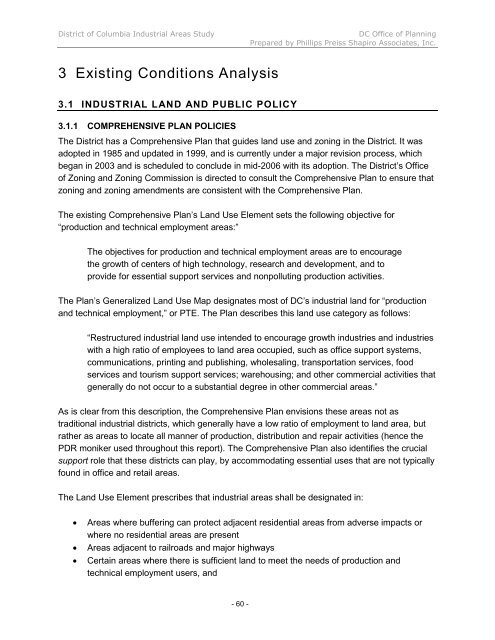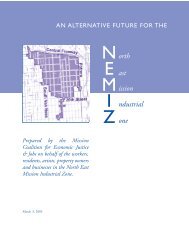INDUSTRIAL LAND IN A POST-INDUSTRIAL CITY District of ...
INDUSTRIAL LAND IN A POST-INDUSTRIAL CITY District of ...
INDUSTRIAL LAND IN A POST-INDUSTRIAL CITY District of ...
You also want an ePaper? Increase the reach of your titles
YUMPU automatically turns print PDFs into web optimized ePapers that Google loves.
<strong>District</strong> <strong>of</strong> Columbia Industrial Areas Study DC Office <strong>of</strong> Planning<br />
Prepared by Phillips Preiss Shapiro Associates, Inc.<br />
3 Existing Conditions Analysis<br />
3.1 <strong><strong>IN</strong>DUSTRIAL</strong> <strong>LAND</strong> AND PUBLIC POLICY<br />
3.1.1 COMPREHENSIVE PLAN POLICIES<br />
The <strong>District</strong> has a Comprehensive Plan that guides land use and zoning in the <strong>District</strong>. It was<br />
adopted in 1985 and updated in 1999, and is currently under a major revision process, which<br />
began in 2003 and is scheduled to conclude in mid-2006 with its adoption. The <strong>District</strong>’s Office<br />
<strong>of</strong> Zoning and Zoning Commission is directed to consult the Comprehensive Plan to ensure that<br />
zoning and zoning amendments are consistent with the Comprehensive Plan.<br />
The existing Comprehensive Plan’s Land Use Element sets the following objective for<br />
“production and technical employment areas:”<br />
The objectives for production and technical employment areas are to encourage<br />
the growth <strong>of</strong> centers <strong>of</strong> high technology, research and development, and to<br />
provide for essential support services and nonpolluting production activities.<br />
The Plan’s Generalized Land Use Map designates most <strong>of</strong> DC’s industrial land for “production<br />
and technical employment,” or PTE. The Plan describes this land use category as follows:<br />
“Restructured industrial land use intended to encourage growth industries and industries<br />
with a high ratio <strong>of</strong> employees to land area occupied, such as <strong>of</strong>fice support systems,<br />
communications, printing and publishing, wholesaling, transportation services, food<br />
services and tourism support services; warehousing; and other commercial activities that<br />
generally do not occur to a substantial degree in other commercial areas.”<br />
As is clear from this description, the Comprehensive Plan envisions these areas not as<br />
traditional industrial districts, which generally have a low ratio <strong>of</strong> employment to land area, but<br />
rather as areas to locate all manner <strong>of</strong> production, distribution and repair activities (hence the<br />
PDR moniker used throughout this report). The Comprehensive Plan also identifies the crucial<br />
support role that these districts can play, by accommodating essential uses that are not typically<br />
found in <strong>of</strong>fice and retail areas.<br />
The Land Use Element prescribes that industrial areas shall be designated in:<br />
Areas where buffering can protect adjacent residential areas from adverse impacts or<br />
where no residential areas are present<br />
Areas adjacent to railroads and major highways<br />
Certain areas where there is sufficient land to meet the needs <strong>of</strong> production and<br />
technical employment users, and<br />
- 60 -












